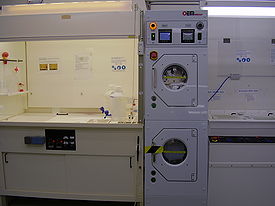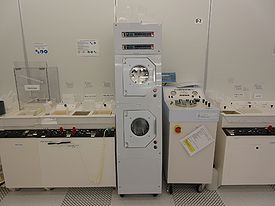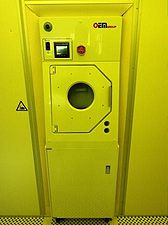Specific Process Knowledge/Wafer and sample drying: Difference between revisions
No edit summary |
|||
| Line 132: | Line 132: | ||
If your wafers are fragile or having thin membranes, cantilevers or suspended bridges that risk to stick or adhere to the surface it can be a good idea to dry your wafers in the ethanol fume dryer. Ethanol is heated to 70°C and your wafers are placed in the fumes of Ethanol which will make the water evaporate from the surface. | If your wafers are fragile or having thin membranes, cantilevers or suspended bridges that risk to stick or adhere to the surface it can be a good idea to dry your wafers in the ethanol fume dryer. Ethanol is heated to 70°C and your wafers are placed in the fumes of Ethanol which will make the water evaporate from the surface. | ||
The Ethanol dryer is placed on a shelf or trolly in D-3 and looks like a US bath. Describtion on how to use is written on the bath. | |||
Revision as of 10:50, 23 April 2024
Feedback to this page: click here
Unless anything else is stated, everything on this page, text and pictures are made by DTU Nanolab.
Drying Comparison Table
| Equipment | Spin dryer 2 | Spin dryer 3 | Spin dryer 4 | Spin dryer 5 | Critical point dryer | Ethanol fume dryer | N2 guns |
|---|---|---|---|---|---|---|---|
| Location |
|
|
|
|
|
|
|
| Purpose |
|
|
|
|
|
|
|
| Batch size |
|
|
|
|
|
|
|
| Allowed materials |
|
|
|
|
|
|
|
Spin dryers
A tool used for drying wafers. A single cassette of wafers is placed in a stainless steel rotor. The wafers are centered just off the axis of rotation, and rotated at high RPM so that centrifugal force “locks” the wafers in place.
Some of the tools have DI water connected, and can be used for both rinsing and drying of wafers, while other tools do not and can only be used for drying. All wafers have to be washed in a wetbench cleaning station before going into the spin dryer, regardless of using the rinse function or not.
The user manual, technical information, and contact information can be found in LabManager: Spin dryer 2 Spin dryer 3
Process information
Standard process is 120 seconds for 100mm wafers or 180 seconds for 150mm wafers, at 2000 RPM - drying only.
If rinsing is used as well, the standard process is 60 seconds of rinse at 500 RPM, followed by 120/180 seconds of drying at 2000 RPM.
- Different places to dry your wafers
-
Spin dryer 2 for RCA cleaned wafers only in B-1. Can take 4" wafers (top) and 6" wafers (bottom).
-
Spin dryer 3 for 4" wafers (top) and 6" wafers (bottom) in D-3.
-
Spin dryer 5 for 8", 6" and 4" wafers in the same chamber, with different carrier holders.
Ethanol fume dryer
If your wafers are fragile or having thin membranes, cantilevers or suspended bridges that risk to stick or adhere to the surface it can be a good idea to dry your wafers in the ethanol fume dryer. Ethanol is heated to 70°C and your wafers are placed in the fumes of Ethanol which will make the water evaporate from the surface. The Ethanol dryer is placed on a shelf or trolly in D-3 and looks like a US bath. Describtion on how to use is written on the bath.
Nitrogen guns
Nitrogen guns are valuable for drying small substrate pieces or samples that otherwise cannot go into the outer drying tools.



